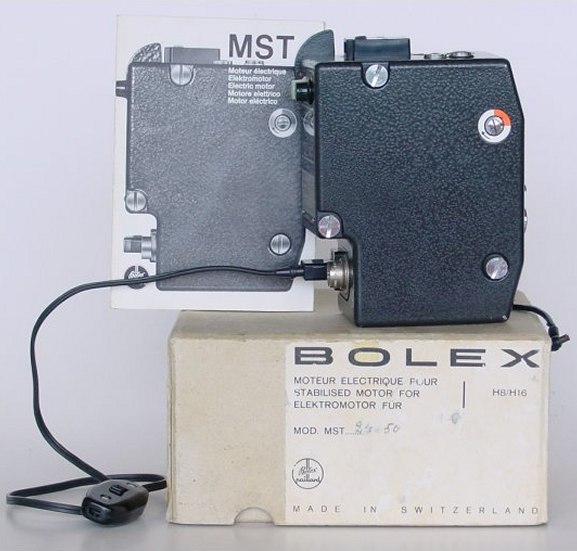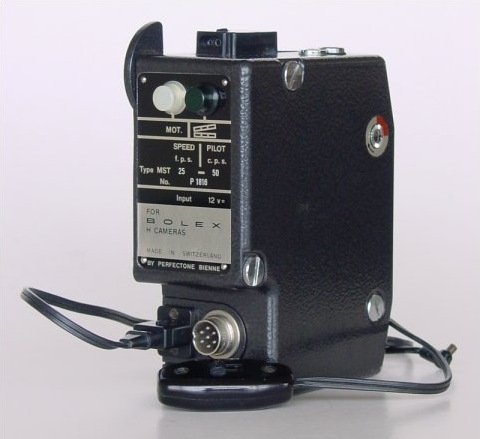Bolex H16 User
For Practical Bolex H16 Filming
MST Motor
Bolex Product Code:- MSTET
| MST Motor Data Table | |
| Drive Shaft Type | 1:1 |
| No of Mounting screws | 3 |
| Filming Speeds in fps | 16.67, 24, 25* |
| Socket for Powering magazine takeup motor | Yes |
| Sync sound to tape | Yes |
| Supply Voltage | 11-15Volts |
 The
Bolex MST motor was the first motor designed to utilise the 1:1 drive
shaft included on all Bolex cameras after 1966. This extra drive shaft
was designed for the express purpose of accurately synching external drive
motors to a tape recorder. Thus enabling you to shoot picture and sound
in perfect synchronisation. The earlier motors were unable to do this
because they connected to the 8:1 drive shaft.
The
Bolex MST motor was the first motor designed to utilise the 1:1 drive
shaft included on all Bolex cameras after 1966. This extra drive shaft
was designed for the express purpose of accurately synching external drive
motors to a tape recorder. Thus enabling you to shoot picture and sound
in perfect synchronisation. The earlier motors were unable to do this
because they connected to the 8:1 drive shaft.
The 8:1 drive shaft does not allow the motor to drive the film through the gate directly but instead the torque is fed through the internal governor of the camera via the fps dial and then the internal mechanisms of the camera to the gate.
Thus the film speed varies ever so slightly from camera to tape because of the internal mechanisms and therefore the speed may not be exactly what you have set it to but may be something just slightly above or below this.
Hence the need for a motor and a drive shaft that directly drives the film through the gate when recording sound. Unlike the earlier motors where you could alter the fps dial on the front of the camera or on the later ESM motor by altering the fps dial on its front, the Bolex MST does not have a way of setting it to film at various speeds. You had to order the motor either to be set to run at 24fps or 25fps or the weird speed of 16 and 2 thirds (which equate s to a thousand frames per minute). You then had to decide what pilotton frequency it would output a signal using. Pilotton was a system designed by NAGRA another Swiss company who specialised and still do today in producing tape recorders for the film industry.
 The
pilotton system writes a frequency either on a channel of the tape or
longitudinally across the tape but phase inverted. This can then be used
to alter the speed of the playing projector or in the lab to make an Answer
Print.
The
pilotton system writes a frequency either on a channel of the tape or
longitudinally across the tape but phase inverted. This can then be used
to alter the speed of the playing projector or in the lab to make an Answer
Print.
There have been two versions of the MST motor, the later version not only allows synchronous recording to tape using the Pilotton system but will also fog a frame of film by the use of a small light put near the gate. This type of MST motor can be recognised by having two metal buttons on the top of the motor, again it was manufactured in all the speeds and Hz values as the first motor.
The motor itself was manufactured by Perfectone
Bennine to Paillard's specification. The motor attaches to the camera
using three screw threads. It also came with its own over the shoulder
battery pack which powers the motor a![]() nd
the 400ft magazines torque motor the MM.
nd
the 400ft magazines torque motor the MM.